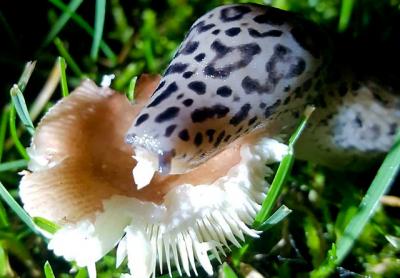Nature Notes: The Remarkable Slug

There are a ton of field guides for birds, butterflies, moths, mammals, fishes, seashells, flowering plants, trees, and even fungi, seaweeds, ants, and, beetles, but who ever heard of a field guide to the lowly slugs.
Well, wouldn’t you know, there is one! “Field Guide to the Slug” by the Western Society of Malacologists was published in 2002 in paperback by Sasquatch Books.
What is a slug, anyway? Slugs rank right up there with sow bugs, smut fungi, rotifers, dung beetles, and no-see-ums in name recognition and popularity. There is yet no official list of world slug species, but it is estimated that there are at least 2,000 of them, compared to 100,000 or so snails, the group from which slugs derived. England has 40 different species, Kentucky 14.
Slugs are seldom seen. Most of them are nocturnal and only come out to feed and reproduce when the humidity is very high or after rains. The one word that describes them to most people is “slimy.” However few there are locally, they were out in force on Saturday and Sunday evenings following rains. It was 1 a.m. Sunday morning when Maryann Buquicchio, who lives in East Hampton, took her ailing dog out for a walk and came upon a leopard slug feeding on a mushroom. This slug, Limax maximus, is one of the world’s largest, as the scientific name suggests. Only a few other slugs, namely those of the banana slug group on the West Coast and elsewhere, are larger.
Leopard slugs are rather common in gardens and in rich landscapes. They feed on a variety of plant stuffs as well as fungi, of which mushrooms are most favored. They are readily identifiable by the black spots covering their five-to-six-inch bodies. One can go out into the dark on a damp night and find leopard slug slime trails sometimes glistening in the moonlight. By dawn they have mostly dried up and are not easily seen. Leopard slugs can move along at a rate of about six inches a minute, not bad for an animal without legs or feet.
They make no sounds but have powerful olfactory senses, so it is by these mucous-y trails that the slugs find each other for socializing.
The leopard slug’s head has two sets of antennae — one for sensing light, the other for smell. They breath air, but only have one lung on one side of the body with a breathing pore to the outside. Slug species are hermaphroditic and capable of self-reproduction, but mating is the preferred way of producing “sluglets.” Interestingly, their penises can be half as long as their bodies.
The fabled banana slugs of California have penises that are up to six inches long, so long that frequently after mating their intromittent organs get stuck and have to be bit off in order to free one slug from the other. They don’t grow back and from that time on sex is a one-way proposition. After fertilization, the eggs are laid in a damp, protected place, hatching out into little slugs three to five weeks later.
The banana slugs take the cake in size but not in manner of reproduction. The leopard slugs engage in one of the most bizarre acts of sex observed throughout the animal kingdom including in humans. Two mature leopard slugs climb up tree trunks, find a suitable branch on which to begin the act of mating, and then, using their rich combined mucous threads, slowly lower themselves down, consummating the sex act in midair, after which they lower themselves to the ground and go on their separate ways.
Hawks and eagles are capable of mating while airborne; one that cannot is a poor mate. Dragonflies and a few other flying insects also mate in the air, none the worse for speed and aerobatics as they go. Such aerial sex naturally selects for the fittest members of the species.
While some human sex acts are weird in their execution, nothing yet compares to the erotic antics of two leopard slugs in love. I suppose that one day in the not-too-distant future, during the midst of the ongoing worldwide sexual revolution, we will read in the daily newspapers or hear on the 6 o’clock news that an infant has just been delivered after being conceived in midair by two sky jumpers.
Larry Penny can be reached via email at [email protected].
